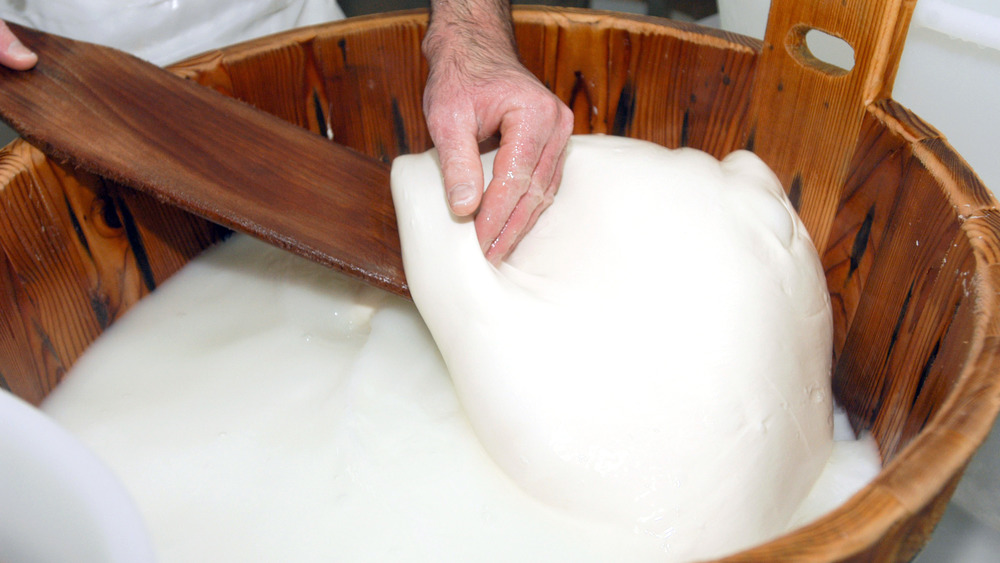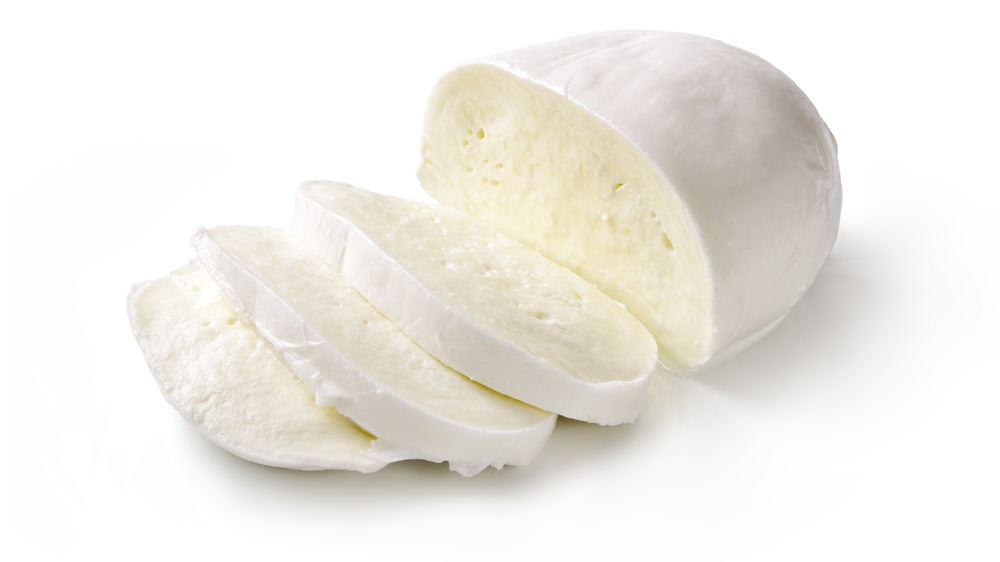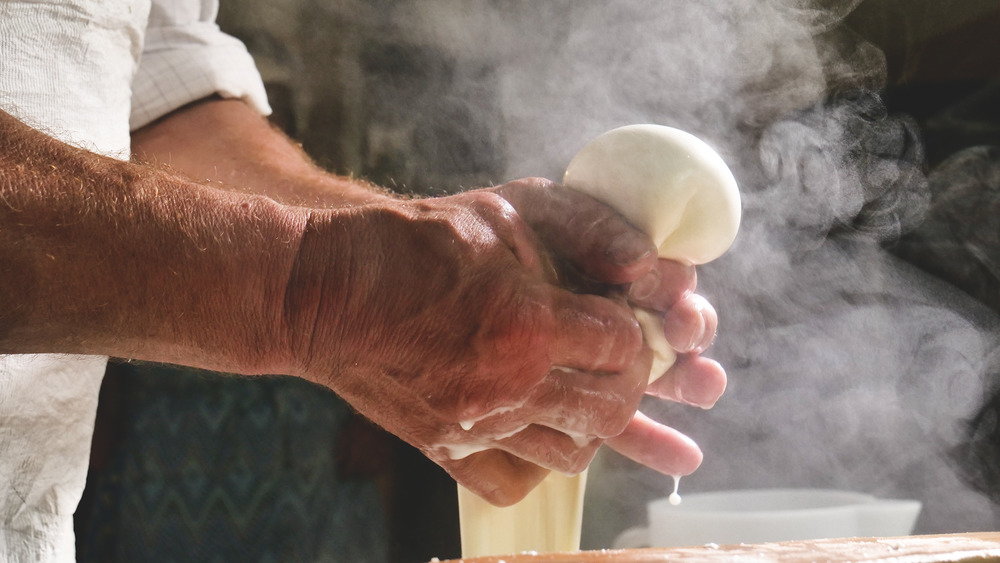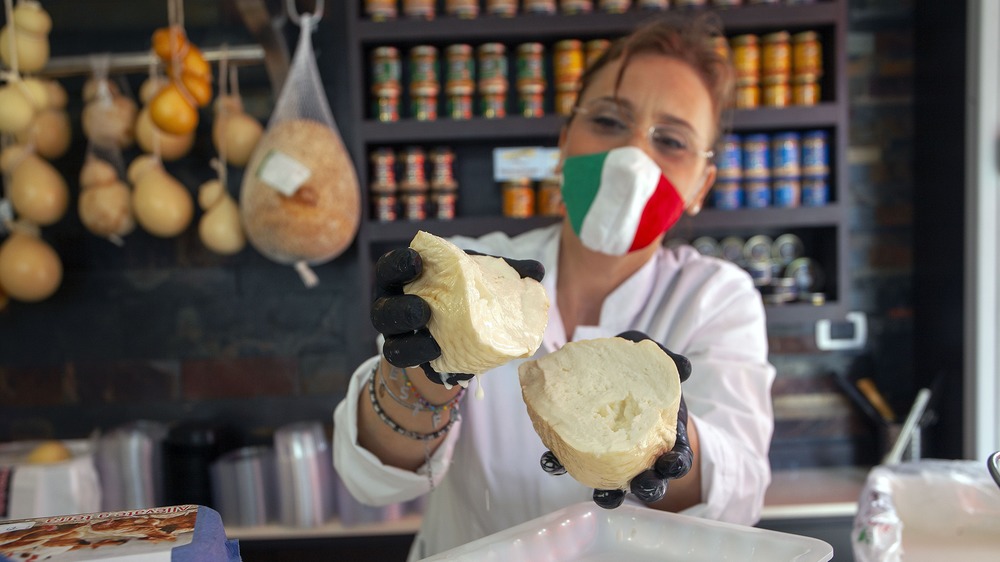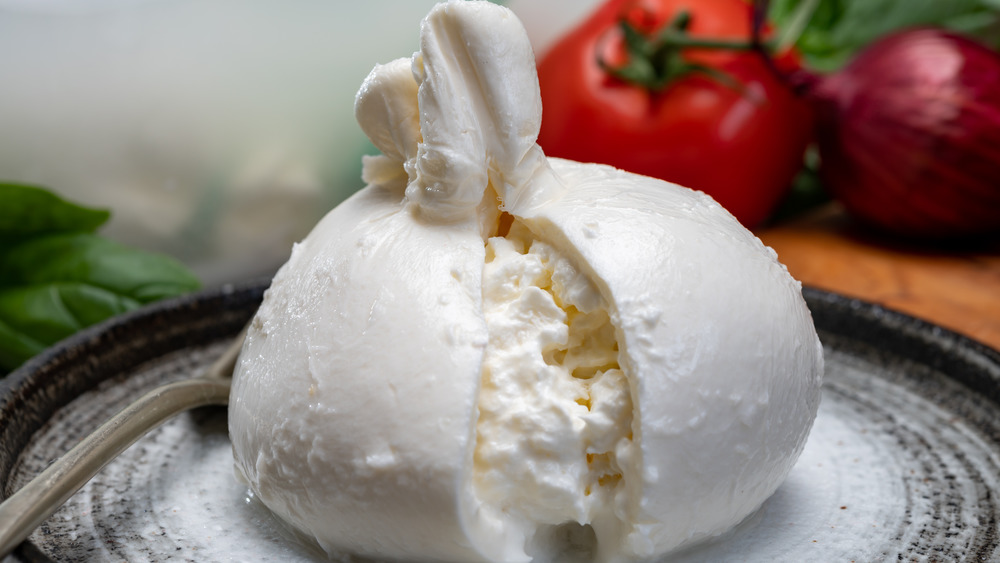The Untold Truth Of Mozzarella
From caprese salads and chicken parmigiana to pizza and its eponymously named fried sticks, it's pretty hard to beat mozzarella. It is a classic and a must-have ingredient for many — and for good reason. It is super versatile, always delicious, and it can be used in a multitude of ways. Did you know that there can be up to 12 (!) varieties of mozzarella, according to Food Republic? Obviously, mozzarella is fantastic regardless, but there are definitely instances in which a certain type is preferable over others. Here's a primer.
The Washington Post notes that mozzarella is one of the best-selling cheeses in the U.S., alongside cheddar, Colby, Monterey, Parmesan, and processed American cheese, but the majority of mozzarella sold in stores is not what originally constituted as "mozzarella" when it was first invented. Cooks Illustrated states that while some may think of Italy when thinking about mozzarella, it's primarily an "American invention."
The original mozzarella was actually mozzarella di bufala and was made in Campania with the milk of a water buffalo (via Food Republic). Of course, that is certainly not the case today, but there are still a slew of exceptional mozzarella options being sold in America.
There are many different types of mozzarella
At their base, all cheeses are a combination of milk, salt, a culture of some sort, and rennet, according to The Washington Post. At some point, you may have seen a cheesy substance being "pulled" in a large pot of water: This is what creates fresh mozzarella. Food Republic explains that the "building block" of fresh mozzarella is curd, which is not the easiest item to find in stores. Making fresh mozzarella from scratch is essentially defined as the process of stretching and folding the curd over on itself, repeatedly, in a mix of warm water and salt. This process is called pasta filata.
Although it's a single process, there are still many types of mozzarella that are made. One fan-favorite is fresh mozzarella. This version is relatively mild, with a slight saltiness and a creamy, soft mouthfeel. It is often packaged in a small amount of water or brine and should be eaten relatively quickly after opening. Fresh mozzarella is excellent when eaten as is, or when paired with cured meats, fresh fruit, nuts, or other cheeses. It can be used on pizza, but fresh mozzarella should be lightly drained on a paper towel and then thinly sliced or pulled beforehand, explains Giadzy; otherwise, the pizza could get soggy.
Note: There are also "mozzarella ball" variations called bocconcini, perlini, and ciliegine, which are essentially smaller versions of mozzarella balls, ranging in size from egg-like to golf ball-sized, says Food Republic. These are sometimes counted as "additional variations" of the cheese.
What is low-moisture mozzarella?
The most common variation — low-moisture mozzarella — is mass-produced, more shelf-stable, and not as loose or watery as fresh mozzarella, according to Serious Eats. It melts exceptionally well, though, so it's perfect for pizza or baked pasta dishes, but not the best option for any sort of raw preparation. The low moisture content and high fat produce some of the absolute best melting imaginable and tends to result in the desired and instantly iconic "cheese pull" moment.
Sometimes these cheeses can veer into a slightly "rubbery" territory (via Serious Eats). The outlet explains that low-moisture mozzarella is also often sold in either full-fat or part-skim varieties; the skim version doesn't melt as "cleanly" and its flavor is slightly less desirable overall, so purchasing full-fat when buying low-moisture is definitely advisable.
Lastly, most pre-shredded mozzarella has been treated with cellulose, which is a food additive that is used to "keep the shreds from clumping together," according to Giadzy. Many are proponents of buying blocks of cheese and shredding yourself, but of course, it's not a huge deal. If you're looking to be as "natural" as possible, though, definitely steer clear of the pre-shredded stuff.
The difference between mozzarella di bufala and burrata
As mentioned before, this is where all mozzarella originated from! This cheese was traditionally made with buffalo milk, but it is now also produced with cow's milk, according to The Spruce Eats. It is richer than the other varieties and has a more pronounced flavor. Mozzarella di bufala is twice as expensive as regular fresh mozzarella and is still very highly regarded in Italy, according to Food Republic. How does this compare to the somewhat similar burrata?
Burrata could perhaps be considered the current "it" cheese after a huge boom in popularity over recent years. It's essentially a ball of mozzarella with an indulgent, creamy center — superb for eating with raw greens or spread on toast and it's the softest and most spreadable of all of the mozzarella varieties (via The Spruce Eats). MyRecipes notes that the center of burrata is actually a mix of heavy cream and stracciatella, which is technically another variety of mozzarella and is a mix of shredded and stretched mozzarella that hasn't fully formed into a full ball.
It's worth mentioning that the name stracciatella is rather common for a few different Italian dishes, so be sure not to mix up the cheese with the soup and/or the gelato! (via MyRecipes).
Scamorza and string cheese are mozzarella, too
The types of mozz don't stop there. Smoked over wood chips, smoked mozzarella (or mozzarella di affumicata), has an edible rind and a very pronounced flavor that is very different from the other mozzarella variations, according to The Spruce Eats. It is delicious both eaten as is or used in cooked preparations and is usually a light brown color.
Scamorza on the other hand is a misshapen peculiarity of a cheese. It is firmer, yellow, a bit aged, but super smooth and melts beautifully. Its strange look belies a really delicious cheese that is not as well-known as it should be — but hopefully the scamorza renaissance isn't too far away!
Then, there's the infamous string cheese. Can you believe it? Yep, those lunchbox stalwarts are technically mozzarella. Of course, they're not really great for anything but snacking, and they don't melt well at all, as Food Republic explains. They certainly make a great addition to any on-the-go meal — no matter if you eat them by pulling strand by strand or (gasp) just eat the whole stick as is. Different strokes!
Other varieties of mozzarella
Beyond these options, there are also are also fior di latte (a cow's milk cheese that is slightly similar to mozzarella di bufala), pecorella (which is made with sheep's milk), and treccia (a cheese braided similar to a challah), according to MyRecipes. What a list!
Nutritionally, mozzarella may not be the healthiest item at the supermarket, but it is certainly a great source of calcium, according to Healthline — especially if you're craving cheese. Healthline also notes that mozzarella has less sodium than most other cheeses, contains "bacteria that acts as probiotics," and has 14% of the recommended daily value of calcium.
At the end of the day, mozzarella really reigns supreme in all of its many varieties. Whether enjoyed raw and paired with fresh fruit and prosciutto, or melted luxuriously over a bed of freshly sauced pasta, the wonders of mozzarella are rich and always welcome. Whether you call it "mozz" or "moozarell" or pronounce it with a mellifluous Italian accent, mozzarella has staked its claim as one of the most cherished and appreciated ingredients being enjoyed today — and we wouldn't have it any other way.
